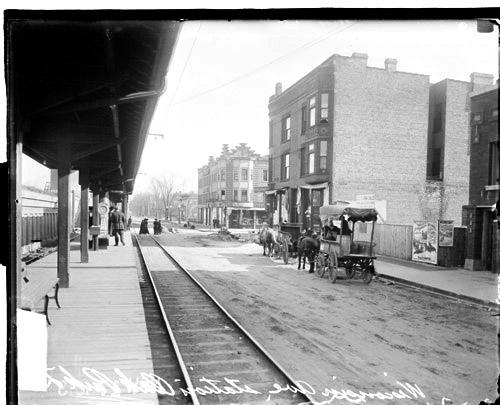|
|
|
|
.
|
|
|
|
.
Marion
(1100W/100S)
Marion Avenue and South
Blvd., Village of Oak Park
Service Notes:
Lake Street Division
Quick Facts:
Address: TBD
Established: January 25, 1901
Original Line: Lake Street Elevated Railroad
Previous Names: Wisconsin Avenue
Rebuilt: n/a
Skip-Stop Type:
Station
Status: Demolished
History:

The Wisconsin Avenue station is seen in 1913, looking east down the track between the platform and street; the new C&NW embankment is visible on the left. For a larger view, click here. (DN-0061521, Chicago Daily News negatives collection, Chicago History Museum, courtesy of the Library of Congress) |
Wisconsin Avenue station -- later renamed Marion Avenue, when the street's name changed -- was built as the terminal of the Lake Street Elevated's 1901 extension along South Boulevard in Oak Park. Lake Street service was extended just a few blocks west into Forest Park on May 20, 1910, when operations were commenced to a new terminal Forest Park Terminal at Marengo Avenue. The "L" was powered by overhead trolley wire along the extension for safety purposes due to the grade-level running. The tracks also paralleled the adjacent Chicago & North Western Railroad.
The modest stations on this portion consisted of island stations and platforms constructed of wood. The narrow station houses with their clapboard paneling and peaked roofs with overhanging eaves emptied out onto an island platform covered by a peaked canopy that was actually a continuation of the station house's roof. The tall steel poles that carried the "L"'s overhead wires occasionally poked through the canopy, interrupting the platform.
The "L"'s street-level operation began to result a number of crossing accidents, typically due to pedestrians and wagon drivers failing to take note of approaching trains. Neither the "L" nor the C&NW had any type of crossing protection originally. Manually-operated crossing gates and gatemen helped reduce accidents but did not eliminate them. The problem got worse as automobile traffic entered the picture and became more prevalent. The situation was further exacerbated when the parallel C&NW elevated their right-of-way circa 1908-09, creating a blind intersection due to the embankment preventing southbound traffic from seeing approaching "L" trains until they were on the crossing. The Chicago and Oak Park municipal governments tried for decades to get the "L" to elevated their tracks west of Laramie Avenue, to no avail.
Finally, in 1961 construction began on a joint project to elevate the Lake Street "L" tracks. The $4 million project was jointed financed by the Chicago Transit Authority (who had assumed operation of the "L" in 1947), City of Chicago, Village of Oak Park, Cook County, State of Illinois, and US Bureau of Public Roads, and in cooperation with the Chicago & North Western Railroad. Rather than build a new elevated structure for the "L", the rapid transit tracks were relocated onto the C&NW's embankment, occupying the southern portion of the elevated right-of-way, which the railroad vacated. The elevation project eliminated 22 grade crossings between Laramie and Harlem avenues.
As part of the elevation project, the stations at Marion and Forest Park were combined and replaced with a new terminal at Harlem. Marion station closed on October 28, 1962. The new Harlem terminal had an auxiliary entrance at Marion Avenue, serving the same area as the old station.
|
|
This Chicago-L.org article is a stub. It will be expanded in the future as resources allow. |
|
|